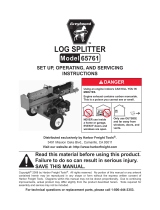
Page 5SKU 97005 For technical questions, please call 1-800-444-3353.
necessary when near the engine’s
magneto or recoil starter.
Use only accessories that are 6.
recommended by Harbor Freight
Tools for your model. Accessories
that may be suitable for one piece of
equipment may become hazardous
when used on another piece of
equipment.
Do not operate in explosive 7.
atmospheres, such as in the
presence of ammable liquids, gases,
or dust. Gasoline-powered engines
may ignite the dust or fumes.
Stay alert, watch what you are 8.
doing and use common sense when
operating a piece of equipment. Do
not use a piece of equipment while
tired or under the inuence of drugs,
alcohol or medication.
Do not overreach. Keep proper 9.
footing and balance at all times.
This enables better control of the
equipment in unexpected situations.
Use this equipment with both hands 10.
only. Using equipment with only
one hand can easily result in loss of
control.
Dress properly. Do not wear loose 11.
clothing or jewelry. Keep hair,
clothing and gloves away from
moving parts. Loose clothes, jewelry
or long hair can be caught in moving
parts.
Parts, especially exhaust system 12.
components, get very hot during use.
Stay clear of hot parts.
Do not cover the engine or equipment 13.
during operation.
Keep the equipment, its engine, and 14.
surrounding area clean at all times.
Use the equipment, accessories, etc., 15.
in accordance with these instructions
and in the manner intended for the
particular type of equipment, taking
into account the working conditions
and the work to be performed. Use
of the equipment for operations
different from those intended could
result in a hazardous situation.
Do not operate the equipment with 16.
known leaks in the engine’s fuel
system.
This product contains or, when 17.
used, produces a chemical known
to the State of California to cause
cancer and birth defects or other
reproductive harm. (California Health
& Safety Code § 25249.5, et seq.)
When spills of fuel or oil occur, they 18.
must be cleaned up immediately.
Dispose of uids and cleaning
materials as per any local, state,
or federal codes and regulations.
Store oil rags in a bottom-ventilated,
covered, metal container.
Keep hands and feet away from 19.
moving parts.
Before use, check for misalignment 20.
or binding of moving parts, breakage
of parts, and any other condition
that may affect the equipment’s
operation. If damaged, have the
equipment serviced before using.
Many accidents are caused by poorly
maintained equipment.
Use the correct equipment for the 21.
application. Do not modify the
equipment and do not use the























